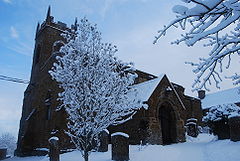Shutford
| Shutford | |
|---|---|
 St Martin's parish church |
|
| Shutford shown within Oxfordshire | |
| Area | 5.51 km2 (2.13 sq mi) |
| Population | 476 (2011 census) |
| • Density | 86/km2 (220/sq mi) |
| OS grid reference | SP3840 |
| Civil parish |
|
| District | |
| Shire county | |
| Region | |
| Country | England |
| Sovereign state | United Kingdom |
| Post town | Banbury |
| Postcode district | OX15 |
| Dialling code | 01295 |
| Police | Thames Valley |
| Fire | Oxfordshire |
| Ambulance | South Central |
| EU Parliament | South East England |
| UK Parliament | |
Shutford is a village and civil parish about 4.5 miles (7.2 km) west of Banbury in Oxfordshire. The village is about 475 feet (145 m) above sea level. In 1870-72, John Marius Wilson's Imperial Gazetteer of England and Wales described Shutford like this:
SHUTFORD, a chapelry in Swalcliffe parish, Oxford; 5 miles W of Banbury r. station. It has a postal pillar-box under Banbury. Acres, 640. Real property, £2,840. Pop., 386. Houses, 98. The living is annexed to Swalcliffe. The church was repaired in 1841. There are chapels for Wesleyans and Primitive Methodists.
The name Shutford is derived from Scytta's Ford. In the fourteenth century the village was quite large. 20 people were assessed for tax in 1327. In 1377 there were 86. A fire in 1701 destroyed 24 houses. Some houses were rebuilt and modernised. In 1774 71 houses were recorded. In the Middle Ages there were 3 manors in Shutford. The manor house appears to have been built in the 16th century. In the Civil War, Viscount Saye and Sele supported the Parliamentarians. Plush and shag weaving was established in 1747 and became the village's main claim to fame.
The Church of England Parish Church of Saint Martin dates from the 12th century, when it was built in the transitional style between Norman and Early English Gothic. The north aisle, two bays of the arcade between this aisle and the nave, and the lower stage of the bell tower survive from this period. In the 13th century the north aisle was extended eastwards with an Early English Gothic third bay. In the 13th or 14th century the nave was rebuilt in the Decorated Gothic style. The south windows, porch and doorway, chancel arch and east window all date from this period. The Perpendicular Gothic windows of the north aisle and the upper stage of the bell tower were added later. The church building was restored in 1841. Since 1955 it has been a Grade II* listed building.
...
Wikipedia

